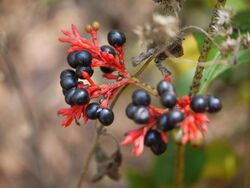Biology:Rauvolfia
| Rauvolfia | |
|---|---|

| |
| Rauvolfia sandwicensis | |
| Scientific classification Error creating thumbnail: Unable to save thumbnail to destination
| |
| Kingdom: | Plantae |
| Clade: | Tracheophytes |
| Clade: | Angiosperms |
| Clade: | Eudicots |
| Clade: | Asterids |
| Order: | Gentianales |
| Family: | Apocynaceae |
| Subfamily: | Rauvolfioideae |
| Tribe: | Vinceae |
| Subtribe: | Rauvolfiinae Benth. & Hook.f. |
| Genus: | Rauvolfia L.[1] |
| Type species | |
| Rauvolfia tetraphylla L., 1753[2]
| |
| Synonyms[3] | |
| |
Rauvolfia (sometimes spelled Rauwolfia) is a genus of evergreen trees and shrubs, commonly known as devil peppers, in the family Apocynaceae. The genus is named to honor Leonhard Rauwolf. The genus can mainly be found in tropical regions of Africa, Asia, Latin America, and various oceanic islands.[3][4]
Spelling
The International Code of Nomenclature for algae, fungi, and plants stipulates that the genus name was established by Carl Linnaeus in his 1753 book Species Plantarum,[5][6] which cites his earlier description[7] which states in Botanical Latin that the name is dedicated "to Leonhard Rauwolf": "Leon. Rauvolfio". Although some subsequent authors hypercorrected the Classical Latin letter "v" to a modern "w", this is not accepted by the code of nomenclature.[8]
Chemical constituents
Rauvolfia serpentina, commonly known as Indian snakeroot or sarpagandha, contains many indole alkaloids.[9]
Medicinal uses
Reserpine is an alkaloid first isolated from R. serpentina and was widely used as an antihypertensive drug[10]
Conservation
Rauvolfia serpentina is declining in the wild due to collection for its medicinal uses.[11] Consequently, it is listed in CITES Appendix II.[12] Rauvolfia vomitoria is a highly invasive species in Hawaiʻi, and is capable of establishing dense monotypic stands.
Species
Species include:[3]
- formerly included[3]
- Rauvolfia celastrifolia Baker = Stephanostegia hildebrandtii Baill.
- Rauvolfia dentata Tafalla ex D.Don = Citharexylum dentatum D.Don
- Rauvolfia flexuosa Ruiz & Pav. = Citharexylum flexuosum (Ruiz & Pav.) D.Don
- Rauvolfia glabra Cav. = Vallesia glabra (Cav.) Link
- Rauvolfia laevigata Willd. ex Roem. & Schult. = Tabernaemontana amygdalifolia Jacq.
- Rauvolfia longifolia A.DC. = Alstonia longifolia (A.DC.) Pichon
- Rauvolfia macrophylla Ruiz & Pav. 1799 not Stapf 1894 = Citharexylum flexuosum (Ruiz & Pav.) D.Don
- Rauvolfia oppositifolia Spreng. 1822 not Sessé & Moc. 1888 = Tabernaemontana oppositifolia (Spreng.) Urb.
- Rauvolfia pubescens Willd. ex Roem. & Schult. = Citharexylum quitense Spreng.
- Rauvolfia spinosa Cav. = Citharexylum flexuosum (Ruiz & Pav.) D.Don
- Rauvolfia stenophylla Donn.Sm. = Alstonia longifolia (A.DC.) Pichon
- Rauvolfia strempelioides Griseb. = Strempeliopsis strempelioides (Griseb.) Benth. ex B.D.Jacks.
- Rauvolfia striata Poir. = Ochrosia borbonica J.F.Gmel.
References
- ↑ "Rauvolfia L.". Germplasm Resources Information Network. United States Department of Agriculture. 2003-03-14. http://www.ars-grin.gov/cgi-bin/npgs/html/genus.pl?10272.
- ↑ "Rauvolfia L.". TROPICOS. Missouri Botanical Garden. http://tropicos.org/Name/40022964.
- ↑ 3.0 3.1 3.2 3.3 "World Checklist of Selected Plant Families". http://apps.kew.org/wcsp/synonomy.do?name_id=176797.
- ↑ Flora of China Vol. 16 Page 157 萝芙木属 luo fu mu shu Rauvolfia Linnaeus, Sp. Pl. 1: 208. 1753.
- ↑ (McNeill et al. 2012 {{{2}}})
- ↑ Linnaeus, C. (1753), "Rauvolfia tetraphylla", Species plantarum: exhibentes plantas rite cognitas, ad genera relatas, cum differentiis specificis, nominibus trivialibus, synonymis selectis, locis natalibus, secundum systema sexuale digestas, 1, Stockholm: Lars Salvius, p. 208, https://www.biodiversitylibrary.org/page/358227#page/220/mode/1up
- ↑ Linnaeus, C. (1737), "Rauvolfia g. pl. 179", Hortus Cliffortianus, Amsterdam, p. 75, https://www.biodiversitylibrary.org/item/13838#page/124/mode/1up
- ↑ (McNeill et al. 2012 {{{2}}})
- ↑ SerpentinaDB
- ↑ "Rauwolfia in the Treatment of Hypertension". Integr Med (Encinitas) 14 (3): 40–46. 2016. PMID 26770146.
- ↑ "India's wild medicinal plants threatened by over-exploitation". International Union for Conservation of Nature. 2008-11-24. http://www.iucn.org/about/work/programmes/species/index.cfm?uNewsID=2326.
- ↑ "Appendices I, II and III". Convention on International Trade of Endangered Species. 2009-05-22. http://www.cites.org/eng/app/e-appendices.pdf.
- ↑ Little Jr., Elbert L.; Roger G. Skolmen (1989). "Hao". United States Forest Service. http://www.ctahr.hawaii.edu/forestry/data/CommonTreesHI/CFT_Rauvolfia_sandwicensis.pdf.[yes|permanent dead link|dead link}}]
Bibliography
- McNeill, J.; Barrie, F.R.; Buck, W.R.; Demoulin, V.; Greuter, W.; Hawksworth, D.L.; Herendeen, P.S.; Knapp, S. et al. (2012). International Code of Nomenclature for algae, fungi, and plants (Melbourne Code) adopted by the Eighteenth International Botanical Congress Melbourne, Australia, July 2011. Regnum Vegetabile 154. A.R.G. Gantner Verlag KG. ISBN 978-3-87429-425-6. http://www.iapt-taxon.org/nomen/main.php?page=title.
Wikidata ☰ {{{from}}} entry
 |


